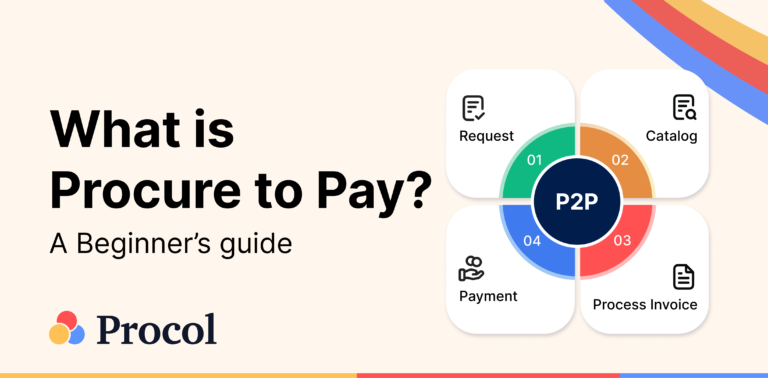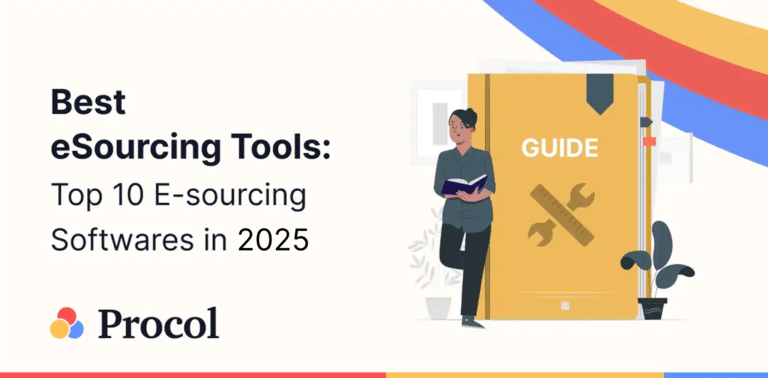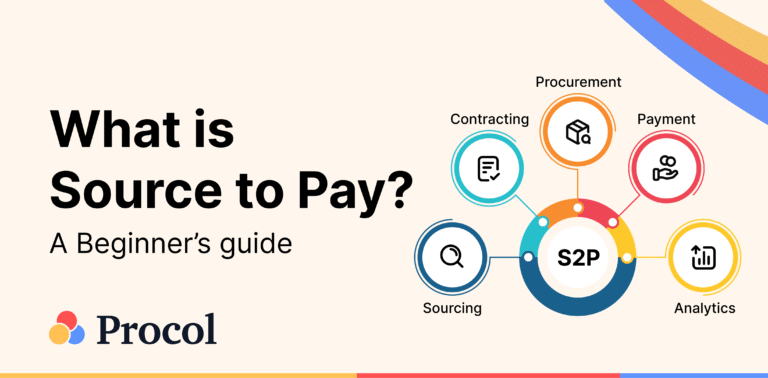Procol • April 15, 2025
What is Expense Management and How is it Effective for your Business?

Introduction:
Expense management goes beyond tracking reimbursements. It’s crucial for financial planning and business insights. In enterprises, it involves constant monitoring, control, and policy compliance.
Manual expense management can be time-consuming and complex. Fortunately, expense management software offers a solution. Expense management software speeds up the process, reduces errors, and automatically quickens reimbursements by tracking employee spending.
Keep reading to learn more about expense management and how software can simplify business tasks.
What is Expense Management?
Expense management describes the meticulous process of budgeting, processing, and managing qualified business expenses. This includes various costs such as travel, employee perks, operational expenses, and more. It involves planning for, paying, tracking, reporting, and reimbursing business expenses, ensuring that each dollar spent advances the company’s objectives.
Critical Components of Expense Management
- Organizations must track and categorize expenses to maintain transparency and accountability. This includes documenting each expense’s date, amount, category, and purpose. Advanced tools and software solutions are often used to streamline this process, ensuring accuracy and efficiency.
- Accounting and finance leaders must establish clear expense policies and collaborate with HR teams to communicate these policies across the company. This ensures that all expenditures align with company objectives and comply with regulatory standards.
- Well-organized approval workflows are vital to handling expense submissions. Automated systems can speed up and improve the accuracy of these processes, helping with quicker decision-making and reducing possible mistakes.
- A smooth connection between the company’s expense management and other financial systems is essential. This link helps automate reconciliation processes and gives a complete picture of the company’s financial situation, making it easier to plan strategies and assign resources.
Expense Management Examples
Costs like rent, utilities, wages, salaries, maintenance, depreciation, insurance, and the price of goods sold are all examples of expenses. Businesses need to make these payments repeatedly to keep running. These costs are vital to keeping the company operating daily and in the long haul. Companies must closely monitor their spending to stay profitable and financially healthy.
How Does Expense Management Work?
Managing expenses typically requires a digital or manual process in which employees submit their expense reports. These reports are then evaluated and authorized by managers or a finance team. Companies commonly use expense management software to streamline these procedures in today’s business world. This software often includes capabilities such as scanning receipts, enforcing policies automatically, and integrating with accounting systems.
The emphasis on monitoring expenses after they have been incurred guarantees that employee spending is based on company regulations and financial plans, minimizing the chances of unauthorized expenditures and financial inconsistencies. By effectively managing employee expenses, companies can have a more secure hold on their finances, enhance employee contentment by promptly reimbursing them, and gain a deeper understanding of spending trends to better anticipate future expenses.
What are the Various Types of Expense Management?
Organizations manage expenses in various ways. Check out the various types of expense management below:
- Paper Forms: Manual and cheap, but prone to lost paperwork and tracking issues.
- Spreadsheets: Spreadsheets offer a manual method of monitoring and controlling spending. People often attach paper receipts to these sheets, which can be tedious and error-prone.
- Software: Expense management software is a smart, efficient solution. It cuts down on work and smoothly handles all steps, from requests to checks, approvals, and data review.
- Telecom Expense Management: Manages communication costs like voice calls, data, and mobile devices. It used to fall under general services and covers wireless and wired services and IT-related costs.
- Travel Expense Management (TE): Often called TE, this organizes travel arrangements and bills for reimbursement and tax purposes.
- Technology Expense Management (TEM): Tracks tech-related costs, including computers, software, and licenses. It provides insights into the efficiency and functionality of purchases throughout their lifecycle.
- Petty Cash Expense Management involves: keeping money on hand for small, pre-approved purchases such as office supplies, bathroom items, or birthday celebrations.
Why is Expense Management Crucial for a Business?
Effective expense management is crucial for organizations as it directly impacts their financial stability and growth. By managing expenses well, companies ensure they spend money wisely, stay within budget, and pay correct taxes. The Internal Revenue Service (IRS) defines business expenses as costs necessary for carrying on a trade or business, which are usually deductible if the business operates to make a profit. Therefore, maintaining accurate and compliant expense records is a financial best practice and a legal requirement.
What is the Difference Between Traditional and Automated Expense Management Processes?
Modern expense tracking beats old-school methods. Here’s where automated systems shine compared to traditional approaches:
| Factors | Traditional expense management | Automated expense management |
|---|---|---|
| Errors | Lots of errors | Most expense management software uses OCR to capture costs automatically. This means fewer human errors. |
| Expense fraud | Outdated expense management systems create opportunities for fraud. Employers can exploit weaknesses in these methods to submit false expense claims. | Automated software with built-in policy checks can effectively identify and prevent fraudulent expenses |
| Compliance | With manual systems, finance teams must review every report to check if it follows the rules. | Automated expense software lets you set policies that flag non-compliant claims right away. This boosts rule-following in your company. |
| Approval time | Approval processes take time. | Approval processes are faster. |
| Real-time data | This is not possible in traditional expense management systems. | Automated expense tools give you real-time spending data. As a CFO, you can see costs by c |
What are the Challenges in the Expense Management Process?
There are various challenges in managing expenses manually. Check out below
1. Limited insight into spending patterns:
Insufficient transparency can pose significant challenges in expense oversight. Effective business management requires a comprehensive understanding of where and why company funds are utilized. Conventional, manual expense tracking systems often delay the complete financial picture until month-end or quarter-end reports are compiled. This lag prevents swift, responsive actions to enhance business expenditures.
2. Unclear expense policies:
Unclear expense policies may cause numerous organizational issues. When staff members are uncertain about allowable costs, they will likely make mistakes in their reimbursement claims, leading to confusion and potential conflicts.
3. Frequency of human errors:
Manual expense management in companies involves significant human involvement, leading to one of the most prevalent challenges: errors caused by human intervention. This human factor introduces the drawback of deliberate or accidental mistakes in the system.
4. Inefficient process:
Does your company handle expense reports effectively? Can it swiftly manage numerous employee submissions? If not, consider implementing advanced technology to accelerate the process and eliminate errors in your expense management system.
5. Inefficient Expense Claim Procedures:
Many expense management issues stem from the initial reporting stage, particularly with conventional systems requiring manual submissions. Traditional expense reporting methods could be more efficient. Employees must manually input expense details, maintain receipt records, and adhere to strict protocols before submitting a claim. These outdated processes often lead to delays, errors, and frustration among staff members. The time-consuming nature of such systems can significantly impact productivity and create unnecessary administrative burdens for employees and finance teams.
6. Avoiding employee expense fraud:
Though regrettable, employee expense deception poses a genuine, troublesome challenge in managing expenditures. This fraudulent behavior manifests in diverse ways. For instance, staff might submit duplicate reimbursement requests, exaggerate actual purchase costs, utilize counterfeit or fabricated receipts for claims, and employ numerous other deceptive tactics.
7. Slow employee repayment process:
How long does your company typically take to repay staff expenses? If your accounting department drags its feet on reimbursements, it could negatively impact your workers’ motivation and efficiency over time.
8. Controlling Spending Limits:
One of the biggest hurdles companies face is keeping expenses in check and handling budgets wisely. It’s often tough to split funds across a business’s many daily costs. This issue becomes even more complex when using old-school expense tracking methods, where you might have to wait weeks or months to see the complete spending picture. Breaking down a budget into various expense groups can be tricky, especially without real-time insights into where the money is going.
Best Practices to Streamline the Expense Management Process
If you plan to implement expense management, check out best practices to streamline your process.
- Expense Policy: Implement an expense policy that defines what expenses can be approved and how much your company can spend. Set category budgets and approval thresholds. Include reimbursement timelines and dispute processes. A good policy is fair, transparent, comprehensive, and clear.
- Expense Reporting: Make it easy for employees to submit expenses. Use digital tools instead of Excel spreadsheets and paper forms to reduce delays and errors.
- Collecting Critical Expense Information: Accept e-receipts to simplify documentation. In your expense policy, outline a clear process for submitting receipts and invoices.
- Timeliness: Encourage prompt expense submission. Set time limits for turning in expense reports within 30 days of spending the money. This helps keep financial records correct and ensures people get paid back.
- Automation: Use expense management software to streamline the process. This reduces manual data entry and mistakes and speeds up approvals and payments. Look for tools that can scan receipts, sort expenses, and work with accounting systems.
- Expense management software: Manual expense tracking is tedious. Compare features and pricing to select the best software for your organization’s needs.
What is Expense Management Software?
Expense management software automates many steps, making the process from receipt to repayment easier. This software helps companies handle travel arrangements, simplify expense report filing, speed up approvals, make reimbursements faster, and keep an eye on expense claims immediately. They automate all aspects of T&E administration to remove risks linked with manual expense handling. Furthermore, cost control tools guarantee adherence to guidelines for all expense claims in your company. This eliminates reimbursements that don’t align with policies.
What is the Need for Expense Management Software?
In addition to offering all the advantages mentioned earlier, automated expense management software tackles many issues related to tracking and reporting expenses.
Automated processes have the perks of keeping employees happy, boosting productivity, cutting costs, and adhering to the rules more. Enhanced reporting aids financial planning and analysis, helping companies assess spending and increase efficiency. Here’s what companies can expect from expense management software:
1. Faster, simpler processes
Automated expense management streamlines the approval process. Employees can now easily submit reports electronically, as the software automatically helps with approval and reimbursement.
This simplification:
- Cuts processing costs by eliminating paper and manual tasks.
- Reduces processing time through automation of approvals and payments.
2. Faster employee reimbursement
Automated systems allow quick submission and approval of expenses, leading to faster reimbursements and improved employee satisfaction.
3. Fewer delays and errors
Expense management software improves accuracy by flagging errors, preventing overpayments, and sending alerts for overdue reports or payments. It can integrate with bank accounts, credit card statements, and travel management systems, reducing manual data entry errors.
4. Increased operational efficiency
Timely and accurate expense reporting maximizes cash flow, especially when billing clients directly. Integration with time tracking, project management, accounting, and ERP software further enhances efficiency. Employees can focus on value-adding tasks instead of mundane expense reporting.
5. Expense policy enforcement
Expense management software helps enforce company policies by:
- Automatically flagging out-of-policy expenses
- Providing real-time visibility into spending
- Ensuring compliance with tax regulations
- Standardizing expense categories and approval processes
This automated enforcement reduces the risk of fraud, improves budget control, and ensures consistent application of policies across the organization.
Even diligent managers may need to pay more attention to new expense policies or tax changes. Automated expense management software enforces custom rules, flagging out-of-policy expenses. It can catch outdated per diem submissions or denials of newly approved items like ergonomic keyboards.
6. Improved visibility
Dashboards in expense management software present employee expense data visually. Managers can quickly view metrics like per-employee spending or average approval times.
7. Enhanced fraud prevention
Fraudulent expense reimbursements affect 20% of small businesses and 13% of larger ones. Automated systems help catch well-hidden fake entries that busy teams might miss.
8. Simplified reporting
Real-time reporting provides insights into company spend. Expense management software allows the consolidation of expenses into single reports. It helps identify high spenders, policy violators, and expense trends. Companies can use this data to negotiate volume discounts and encourage employee frugality.
9. Increased compliance
The software aids in tax compliance by categorizing expenses correctly. It flags non-deductible items that might attract IRS attention. Electronic copies of reports and receipts are easily accessible during audits. These features help companies clarify and enforce spending policies while maintaining regulatory compliance.
Why is Procol the Best Expense Management System for your Organization?
Procol is an AI-based procurement platform that streamlines buying processes, cuts acquisition costs, and manages your expenditures. The software manages business expenses and travel. It provides real-time expense monitoring, streamlined approval processes, and compatibility with standard accounting tools. The software caters to companies across various sectors and sizes.
Conclusion
Expense tracking is one of many crucial financial tasks companies opt to digitize to boost operational productivity. Expense management tools automate reimbursements and keep precise records for taxes, compliance, and better oversight of daily costs. By removing manual expense logging, you free up time to examine your financial data instead of gathering it. The insights from your records enable you to make smarter choices that fuel growth.
Explore more from Procol
Discover expert tips, how-to guides, industry insights, and the latest procurement trends.

What is Procure-to-pay (P2P)? An Ultimate Guide
Procure to pay is the process from procurement of materials needed...

Best eSourcing Tools: Top 10 eSourcing Software in 2025
Discover top 10 e-sourcing tools and esourcing platforms necessary for efficient...

What is Source-to-pay in 2025? An Ultimate Guide
Source to pay is the process of sourcing vendors to procure...











